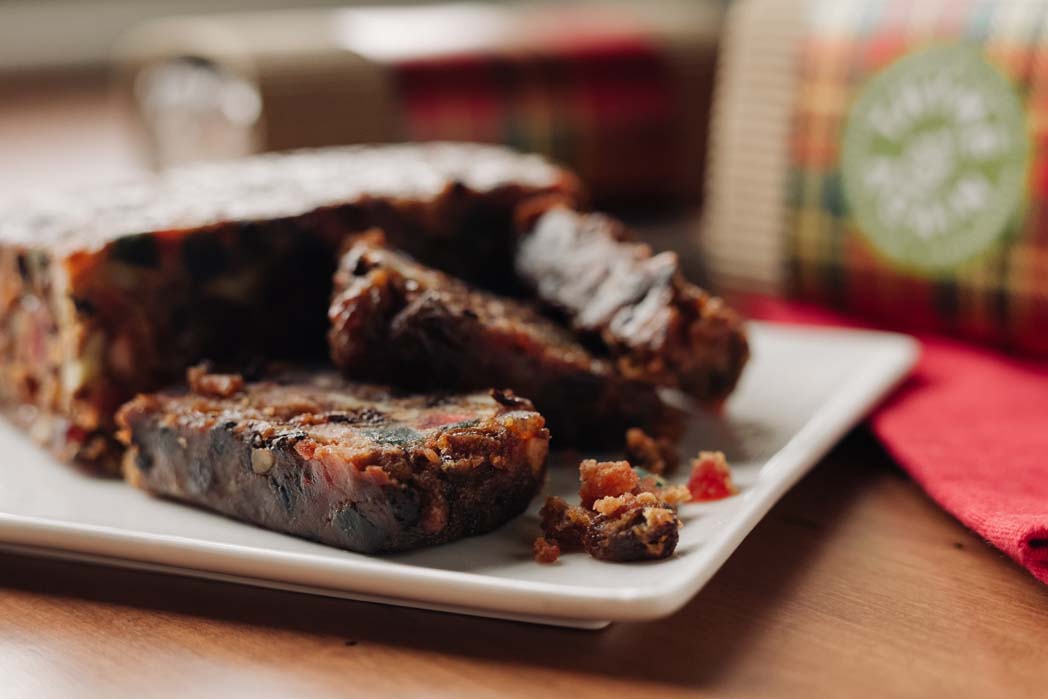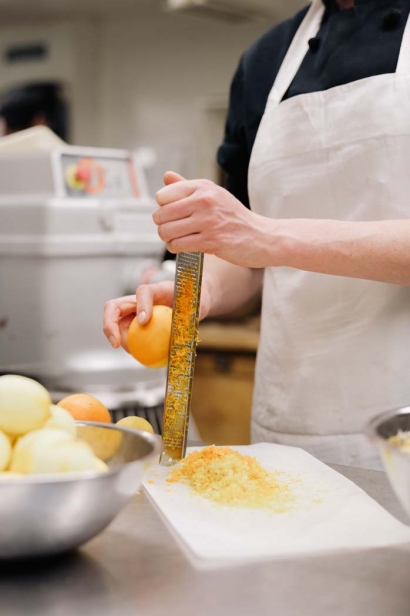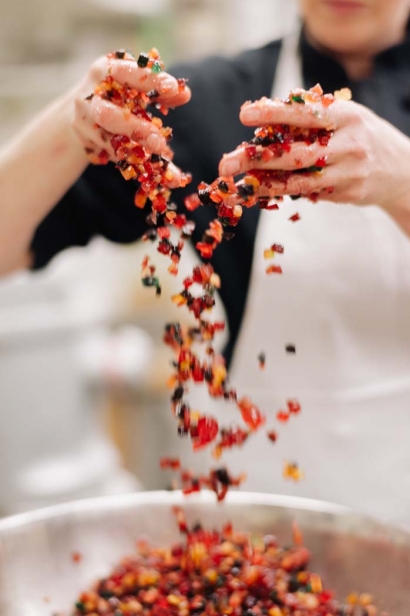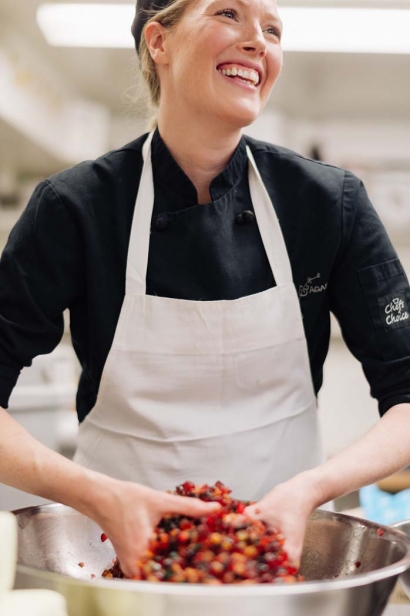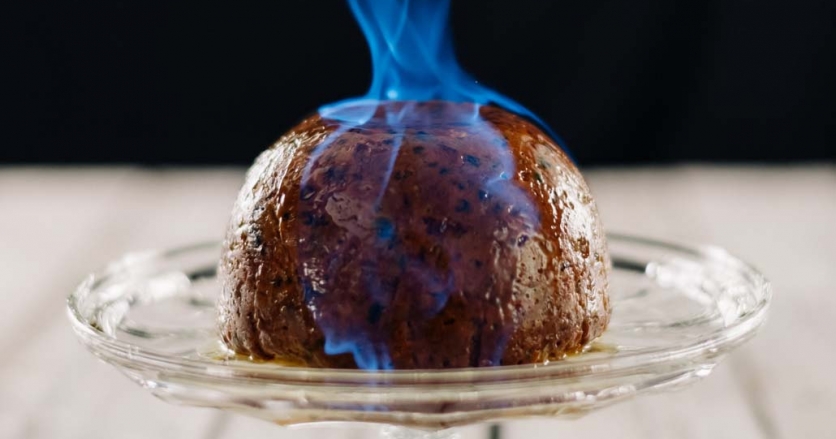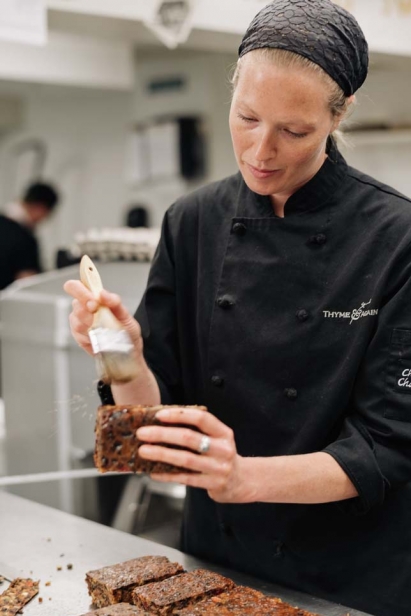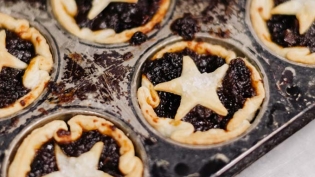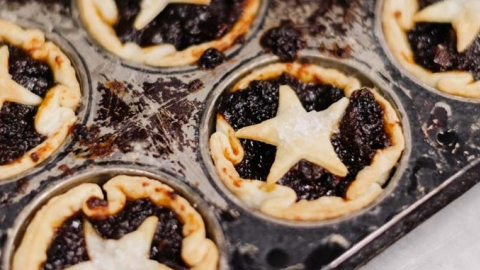Seven-Month Fruitcake and Flaming Plum Pudding
There’s no in-between. You either love it, or you hate it. It’s a part of your childhood and family traditions, or it never gets a second glance after the turkey, cranberry sauce and roast potatoes arrive. Traditional Christmas cake, that is.
I grew up looking forward to the white, snow-covered scene of a Christmas cake, complete with a sprig of holly, a small red toboggan, miniature green Christmas tree and tiny, hatted figure, dancing across the hard, frosted surface. Hardly had we finished the lunchtime feast, than it was time for a cup of tea and cake. When I moved from the U.K. to Canada 18 years ago, it quietly disappeared from my culinary life. Real, heavy as a brick, packed with dried fruit and soaked with brandy, Christmas cake wasn’t easily found.
If you look carefully, however, you can find the real deal in Ottawa. Thyme & Again Creative Catering and Take Home Food Shop on Wellington Street has been making traditional Christmas cakes, plum puddings, Christmas cake truffles (made from the off-cuts of cakes and dipped in bittersweet chocolate) and mince pieces for longer than anybody can quite remember. “The owner of the space prior to us taking over used to make fruitcake and cover it with chocolate,” recalls Sheila Whyte, the owner of Thyme & Again, now an Ottawa institution that has just celebrated 25 years in business, “so, a few people asked for it. And since we grew up with fruitcake and plum pudding in our house, it was natural for us. I believe one of our first cooks supplied the recipe from his mother.” They produce more than 550 cakes of varying sizes to celebrate the holiday season, 150 plum puddings and close to 1,500 fruitcake truffles. This year, they’ll be offering gluten-free Christmas cake for the first time. And they start their preparations in June, when the rest of us are dreaming of hot summer days, salads, barbecued steak and ice cream.
In the large and busy basement kitchens at Thyme & Again, it takes Kylie Anglesey, head pastry chef, a full five minutes to crack 92 eggs for the first batch of cakes. To these she adds six pounds of butter, bucket loads of sultana raisins, walnuts, mixed peel, which includes lemon and orange peel, pineapple, cherries and currants and dark brown sugar, which arrives by the 20-kilogram sack. Spices, such as cinnamon, ginger and nutmeg, go in before an industrial mixer gets the lot moving.
Next, Anglesey grates fresh lemon and orange zest and adds molasses and a very small amount of flour. For such a dense cake, at the end of the process, it’s surprising how little flour goes in at the outset. By the end of the ordeal, which requires elbow grease, sticky hands and the ability to lift great weights, Anglesey has produced a bowl the size of a toddler’s swimming pool of an unappetizing, pale brown-flecked gooey mess. But despair not. An hour and a half in the oven will result in dark chestnut-coloured, rich, moist, aromatic cakes that scream "Christmas".
Over the following five months, these cakes will wait patiently in a dark corner, stacked floor-to-ceiling, to be fed and watered approximately once a month with a brandy and simple sugar syrup mix, carefully applied with a pastry brush. This is what gives them their dark, sticky and moist texture and preserves them for such a long time.
In the form we know it now, Christmas cake came into existence in early Victorian times. It developed over many hundreds of years as the focus of celebrations shifted from the Twelfth night — the date that marks the arrival of the Magi at the crib of the baby Jesus — to Christmas. Wealthy families enjoyed plum porridge, traditionally eaten on Christmas Eve. However, over the years, oatmeal, the traditional base for plum porridge, was replaced by butter and flour; then dried fruit was added and finally spices, a symbolic nod to the Three Kings. The Christmas cake was born and while it was also enjoyed at Easter for a period, is now recognized as a Christmas tradition, complete with a marzipan covering and white, frosted icing.
Anglesey, who trained at the Stratford Chefs’ School, has been on the Christmas cake beat for six years, “and I quite like it now,” she says. “I didn’t at first.” It’s true — Christmas cake is an acquired taste.
As is plum pudding. Now, if Christmas cake is a hard sell, then plum pudding is bordering on the exotic. “As a child I didn’t like the dryness of Christmas cake,” says Whyte, who, with her husband, Clayton Kennedy, a paleontologist at the Museum of Nature (now retired) and one employee Rose Goyette, now general manager, started Thyme & Again in 1991 in a 400-squarefoot storefront in Hintonburg.
“It was the Christmas pudding that I chose. But then I realized that it wasn’t actually the pudding itself, but the hard sauce that went with it that I loved.” Thyme & Again, now sells upwards of 150 plum puddings with a steady small increase in numbers year-on-year from 1,200 square feet of retail space on Wellington Street West.
“Many of our sales are to repeat customers,” explains Whyte. Of course, they sell the hard sauce (also known as brandy butter) too. “It’s a hard, white icing made from icing sugar, butter and brandy,” explains Whyte, “and you put this cold, hard icing onto the hot pudding and it melts.” Christmas dinner just isn’t complete without the pudding, hiding a silver sixpence inside, decorated with a tuft of holly and flaming blue with brandy, paraded into a darkened room to rounds of applause. Brandy butter optional.
Christmas, or plum pudding doesn’t actually feature any plums at all. It’s another variation on dried fruit of all varieties such as currants, raisins, candied peel and a whole host of spices. such as mace, cinnamon, nutmeg, allspice and ginger, with the strange addition of beef suet (fat) and plenty of brandy to bring it all together. Traditionally, Christmas pudding was made a whole year in advance to allow the flavours to develop. It’s another Victorian invention.
The third string to Thyme & Again’s Christmas bow is the mince tarts and pies. Less an acquired taste and more mainstream, they produce thousands of the mini three-bite pies and hundreds of 10-inch tarts, made from light, flaky pastry, a sweet filling bursting with apples and cinnamon among other flavours, and decorated with pretty pastry stars and coarse sugar crystals. These, of course, are made in the busy weeks of late November and early December and don’t require the lengthy treatments of brandyinfused cakes.
Okay, so you may prefer eggnog. But this year, give a traditional Christmas cake a try, or at least a mince pie or two. Rumour has it that Santa likes them.
Thyme & Again Creative Catering and Take Home Food Shop
1255 Wellington St. W., Ottawa
thymeandagain.ca, 613.722.0093


